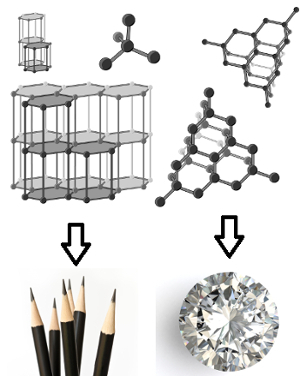In the text what are all things made of it was explained that everything is made up of tiny particles called atoms and that the chemical elements they are formed by atoms of the same type.The atoms that make up each element differ by the amount of protons (positive particles present in the nucleus).
Carbon, which is a chemical element, is also made up of a set of equal atoms. All carbon atoms have six protons in their nucleus. Below we have a drawing that represents two models of how the atoms that form carbon would be:

carbon atom models
All known elements are registered in the Periodic table, from the lightest, which is Hydrogen (H - with a proton), to the heaviest, which so far is Ununoctio (Uuo - with 118 protons).Carbon also appears in the Periodic Table as the sixth element counting from left to right:

Carbon element in the Periodic Table
Carbon has a special property:it can make four different chemical bonds.This means that, in addition to being able to unite with atoms of other elements, such as hydrogen, oxygen, the nitrogen, sulfur and phosphorus, carbon can also bond in different ways with other atoms of carbon.
The result is the formation of thousands of carbon compounds that are present in nature, in rocks, in minerals, in products made in industries, in plastics, in smoke, in oil, in plants and inside our own bodies.
For you to be able to imagine how this happens, think of carbon as a gray ball and see below how its atoms bond and form different types of substances:

Illustration of carbon substances
Just below we have the representation of the diamond and the graphite that comes inside the pencil we use to draw and write. Do you know what these two materials have in common?It may not look like it, but the two are made up only of carbon atoms.
We know they are totally different, but that's because their atoms are joined in different ways. See the structure of each one:

Structures formed by pure carbon, graphite and diamond
The gasoline that makes the car move is made of various carbon compounds, such as those shown below:

Heptane and isoctane are some of the carbon compounds that make up gasoline
When we breathe or light a fire, we release carbon dioxide into the atmosphere, which is also a compound of carbon (CO2).
Our body is made up of carbon, in addition to other chemical elements. In fact, all known life forms, including humans, animals and plants, must contain carbon in their constitution.
By Jennifer Fogaça
Graduated in Chemistry

